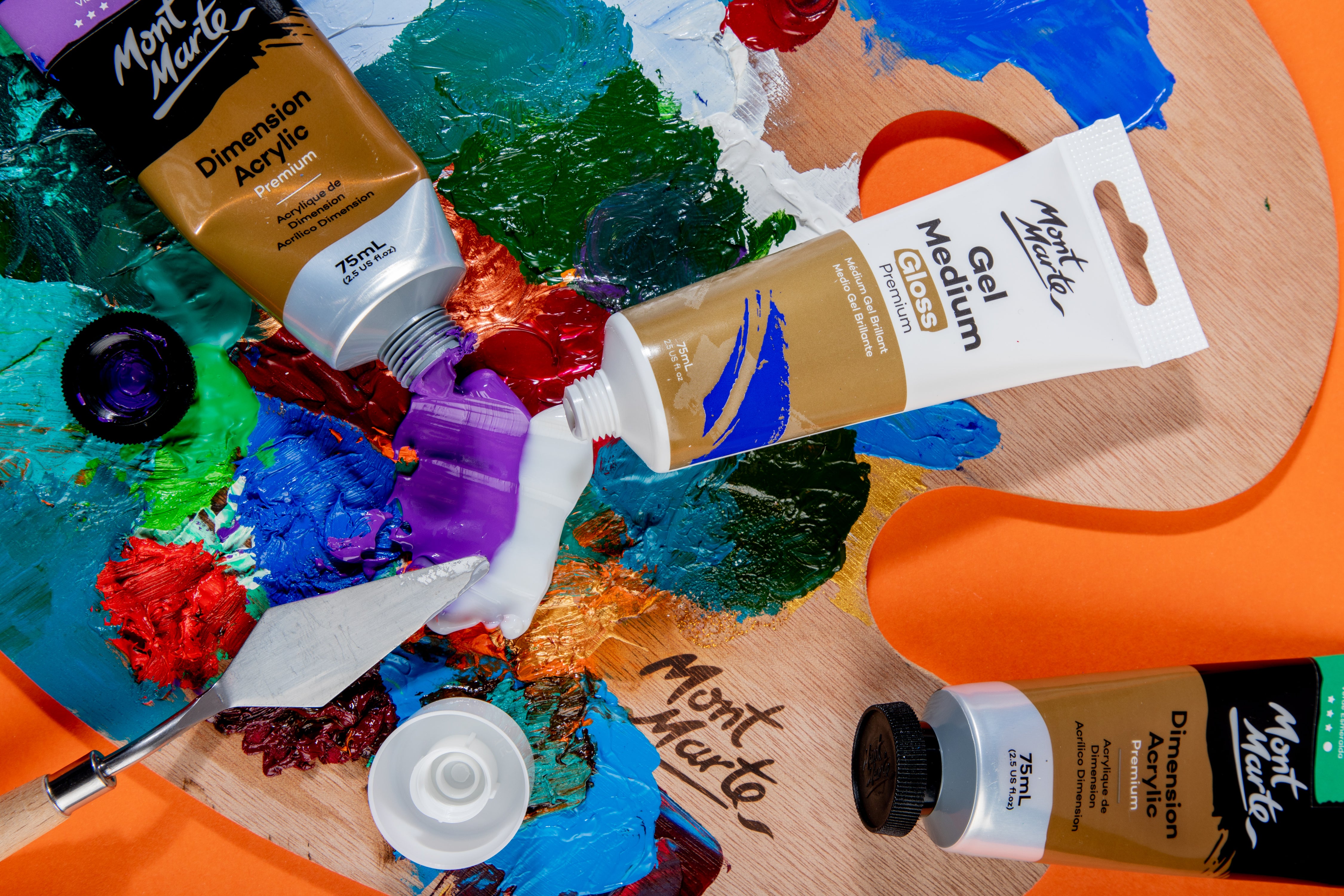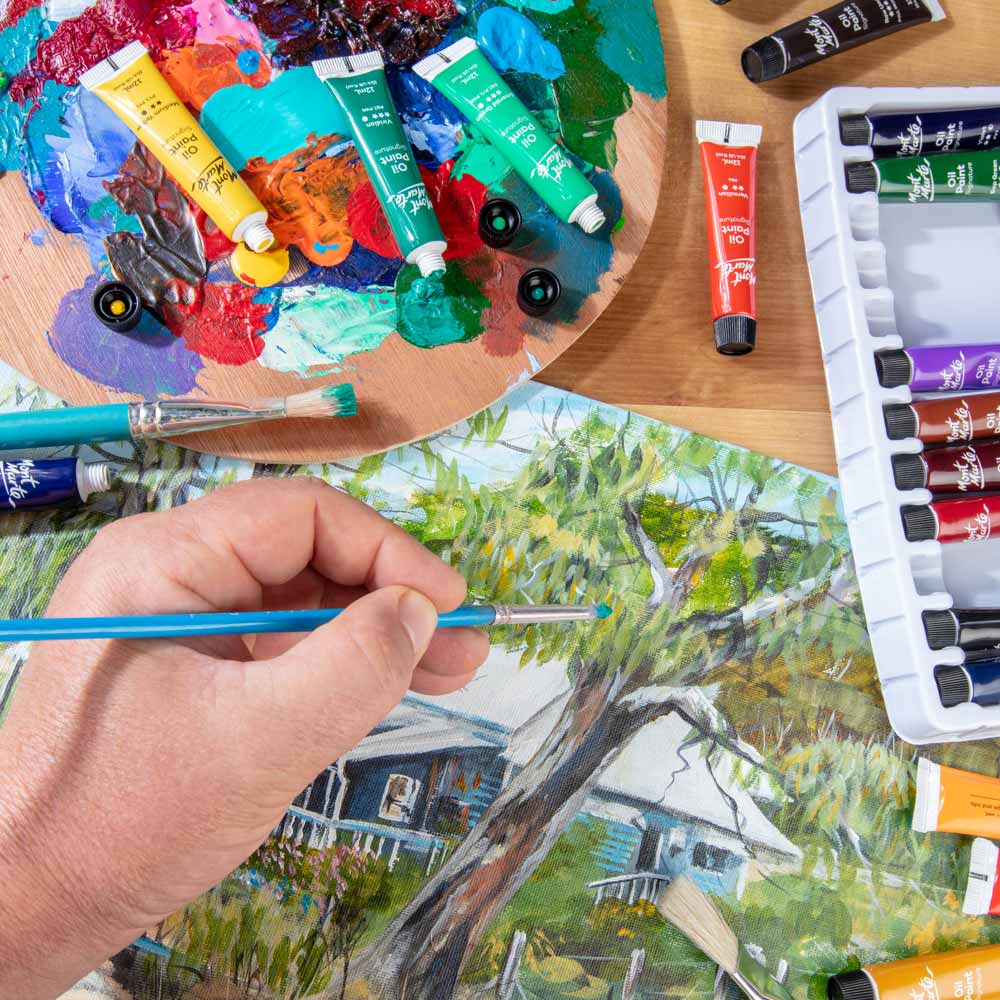We’ve put together a handy Q&A blog based on questions you asked us to help you feel confident when using mediums for your next project. Art mediums are super handy for changing the consistency, drying time, and translucency of your paint, as well as priming your paint surface. There are all sorts of mediums for all kinds of purposes, so discover which one might suit your art style the best below!
1. Can mediums be used to create texture?

Yes, they sure can! There are different painting mediums for different results so it’s good to have a look at the range and see which effect you want.
We’d recommend using Impasto for ‘chunking up’ acrylic paint. It will make it thicker and give you lots of body. Depending on the effect you’re after, you could also use our Modelling Paste on the surface of your canvas. Allow it to dry, and then paint over the top of it to create texture under your paint. Our Crackle Paste can be used in a similar way to create a unique texture beneath your layers of paint. Lastly, you can always drop some sand or gravel into the paint to create a finer grainy texture.
We’ve got some handy hints for achieving textured effects with our mediums. Check out our video on how to create texture in artwork with acrylic mediums for some inspo!
2. Can gesso be used over an acrylic painting to add texture?
Gesso can achieve different effects depending when you use it and which type you use. Our Clear Texture Gesso is designed to add tooth (i.e., grip) to your canvas so you can use dry media with it (e.g., pencils). It’s more of a primer that you can use to make your painting surface more porous so your paint, pastels, pencils, etc. bind to it better.
Having said this, you can create texture underneath your paint by using our Premium Gesso before applying colour. You can do this by spreading the gesso thickly onto your blank canvas, with the optional use of texture tools, and letting it dry before going ahead with your paints! We’ve got a handy how-to video on this to run you through using gesso to create texture!
3. How do you use the Crackle Paste?

To use our Crackle Paste, apply a thin layer of the paste to your art surface and allow it to dry before painting. If you’re wanting to create a larger crackle effect, apply a thin layer of PVA glue to your surface and wait until it is dry before applying the crackle. Allow the crackle to dry and then paint over the top. Simples!
4. Will flow medium affect the finish of your paints?
Good news - our Acrylic Flow Medium should not affect the finish of the paints you are using, assuming you’re following standard ratios (i.e., 1 part flow medium to 4 parts paint for general use). The colours will stay intense even as they become more fluid, so your work remains nice and vibrant. If you are using a ratio of more flow medium than paint (e.g., 3 parts flow medium to 1 part paint) it would dry to a semi-matte finish.
5. Does impasto change the colour of the paint?
Mont Marte Impasto does not change the colour of your paint. The impasto dries clear (like PVA glue), so it doesn’t pale or soften your colours when mixed. If you’re going to use lots of it, it will create a bit more translucence in the colour of your paint (rather than changing the hue). All in all, it has little effect on your paints other than thickening them for a more defined texture.
6. What is acrylic retarder?

Acrylic retarder can be used to slow down the drying rate of your acrylic paint. The paint will still dry fairly quickly, but it will give you a little bit of extra time to blend your colours. We recommend a mixing ratio of 1 part medium to 4 parts paint for best results but always feel free to experiment and practice different quantities before committing to your painting surface.
7. What is the difference between your Premium Gesso and White Texture Gesso?
We get it – the gesso game can be a little confusing! Basically, our Premium Gesso (MPA0032) is highly opaque and dries to a semi-matte finish. It can be used to create texture as a base layer under your paints as it will hold its shape when applied thickly.
Our White Texture Gesso (MPA2501) is more of a general-purpose gesso that is less opaque and dries to the texture of fine sandpaper, providing more tooth so dry art supplies bind to the surface (e.g., chalk pastels, pencils, etc.). Unlike the premium gesso, it will level out more, drying flatter with less shape. It’s great to prime your painting surface, as it creates a more porous texture so other mediums can fix to it.
8. Can you use varnish on watercolour?

Traditionally watercolours are not sealed with a varnish or medium as they can change the look of the paint. Having said this, that shouldn’t stop you as you absolutely can use varnish over watercolour – just be aware the paint may look different! For example, our Premium Iridescent Varnish has a holographic shimmer finish which may add an extra dimension to your watercolour project. Just remember to apply it once the paint has dried, not while it’s wet.
9. Can you thin paint with art mediums?
Thinning paint is great for pouring or airbrushing, as well as creating a more fluid colour to work with. You can always thin paint with water, but it can dilute the opacity a little. Mediums are great for thinning your paints without making them overly transparent. Our Acrylic Flow Medium is great for this and is so simple to use – just combine it with your paint until you achieve the desired viscosity. While large quantities of flow medium can affect translucency, it’s usually only when the mixing ratio is skewed towards more medium than paint.
When thinning oil paints, your go-to mediums will usually be oils – unsurprisingly! We carry three kinds of oils that are great for adjusting the viscosity of your paint, including Refined Linseed, Thickened Linseed, and Safflower oils. Refined and thickened linseed oils can both be used to thin your paint, as well as improve their flow for easier application. Thickened linseed oil has more of a syrupy consistency while the refined version is less thick and slows the paint-drying process down. Lastly, safflower oil resists yellowing and increases the gloss of your paints in addition to thinning them to improve the flow.
We have a neat video that goes over how to thin acrylic paint, as well as a handy guide to our oil paint mediums that may help you with your next project.
10. What is varnish used for in painting?

Varnishing can make the colours in your artwork more vibrant and protect your paintings from dust and dirt. Varnishing will also waterproof clay, canvas, and wood, meaning your works are able to last longer. We carry a range of different varnishes, including an Iridescent Varnish, Gloss Acrylic Varnish, and Gloss Clay Varnish. You can also finish your acrylic paintings and artwork with our acrylic mediums (matte and dry finishes available) to protect and intensify your work. We’ve got another FAQ article devoted to answering your most pressing varnish questions!
11. How do you use ceramic medium?
Our ceramic paint sets come with mediums to help you get the most out of the product. It can be used to add translucency to ceramic paints, making them great for colour layering. Similar to most other mediums, simply mix it into your ceramic paints in various amounts to increase their transparency for glaze effects and layering. You can decide how much you would like to add based on how translucent you want the colour to look. Add it bit by bit until the colour looks right for the effect you are creating. You can also use the medium to seal porous surfaces and prime your ceramic for a more even underlayer.
For more info, check out our how-to video which shows you the best way to get the most out of your ceramic paint medium.
12. What mediums work best for pouring?

Acrylic paints need a medium to become more fluid for pouring, as well as a silicone oil to make cells on your painting surface. Whilst we carry both Pouring Acrylic Paint (which is fluid enough without medium) and Supercell Pouring Paint (that is fluid plus doesn’t need anything extra to make cells), we do have a range of mediums to help transform any acrylic paint into a great pouring product!
Firstly, we have our Acrylic Pouring Medium which is made to mix into acrylics for fluid art. This medium improves the flow of your paint, thinning it so it pours easily. For best results, the recommended ratio is 2 parts medium to 1 part paint, mixed together in a cup with a palette knife until it’s the consistency of pouring cream. To thin more, add water, to thicken, add paint! You can even just use a small amount of this medium in your paint to create smooth brushstrokes when not pouring.
We also carry an Acrylic Flow Medium which can be used with a standard acrylic paint to create pouring paint. Add it in moderation to acrylic paint to achieve a range of effects, from silky, long brushstrokes, to fluid art. It’s often used for spin art and lettering, as it can be added in varying amounts to create the desired viscosity you need for your project. Large amounts of the medium can be used to increase paint translucency for a glaze style effect.
Lastly, our Silicone Oil is a great go-to for creating stunning cells and effects in your fluid art. For best results, we recommend adding a maximum of 2-3 teaspoons of silicone oil to 200ml of pouring paint. After pouring, you’ll notice the dynamic cells and patterns emerging as you tilt the surface to cover the edges. Check out our in-depth video to learn how to use silicone oil in paint pouring.
13. Can you mix pigment powders with mediums?
Yes, you can! Our clear mediums, such as the Acrylic Medium Gloss or Gel Medium Gloss, are the best fit for the job. These are good for creating a smooth texture and combining well with the pigment to make a more even colour.
It is possible to use gesso with powder pigments, however, the consistency will not be as smooth, and the colour will look a little washed out due to the textured powder. Best to stick with an Acrylic or Gel Medium instead!

Now you’ve learned a little more about art mediums, we hope you feel like you can explore their many uses and experiment at home!
We’d love to have inspired you to start a new project, return to an old one, or even just think about the viscosity and texture of your paints.
If you do get creating, #montmarteart or tag us @montmarteart on Instagram or Facebook. We’re excited to see any exploration or artwork you come up with!
Looking for more? Check out our Artist Gallery for some inspiration. If you need any of the products mentioned in this blog, jump online to check out our range of art mediums.





































